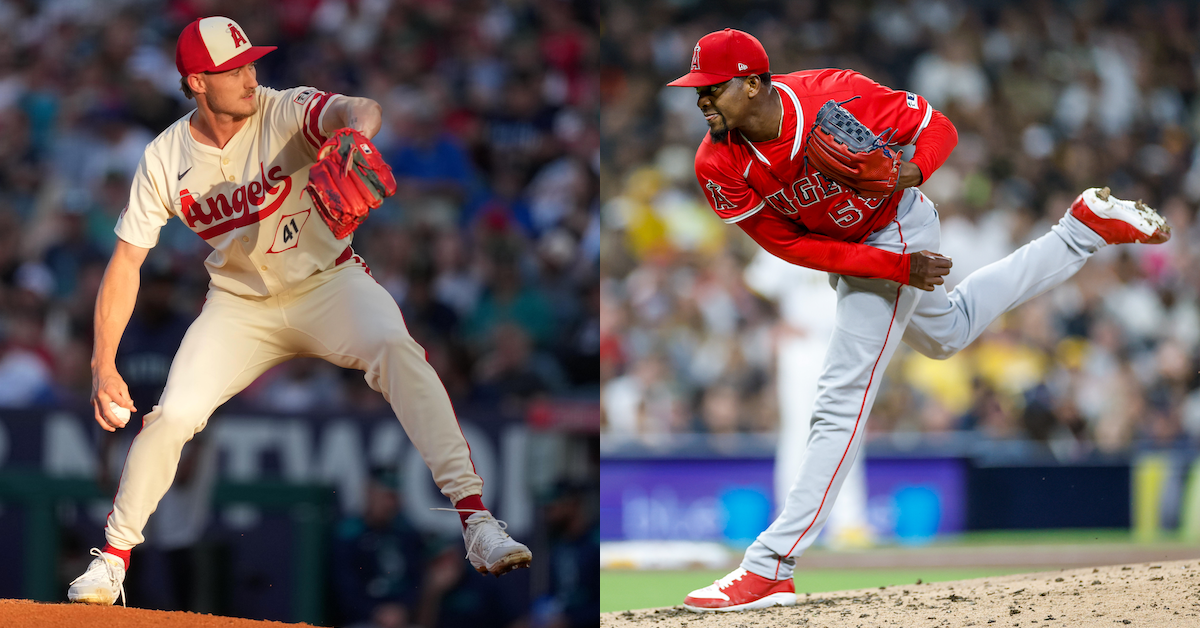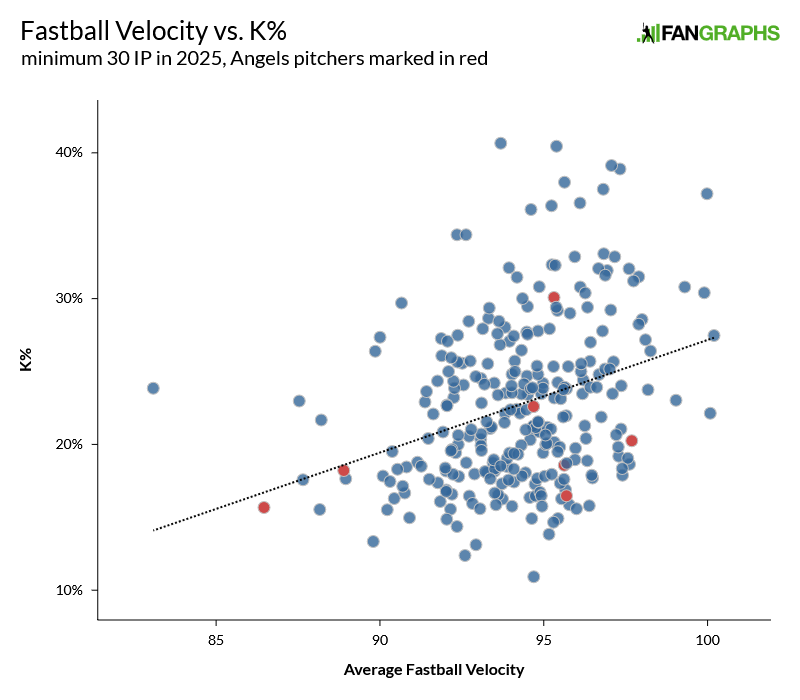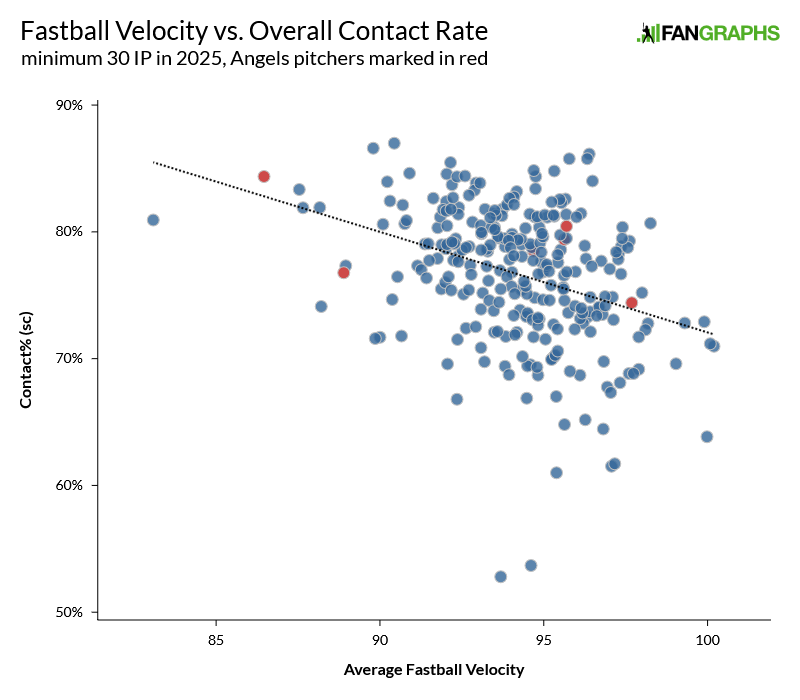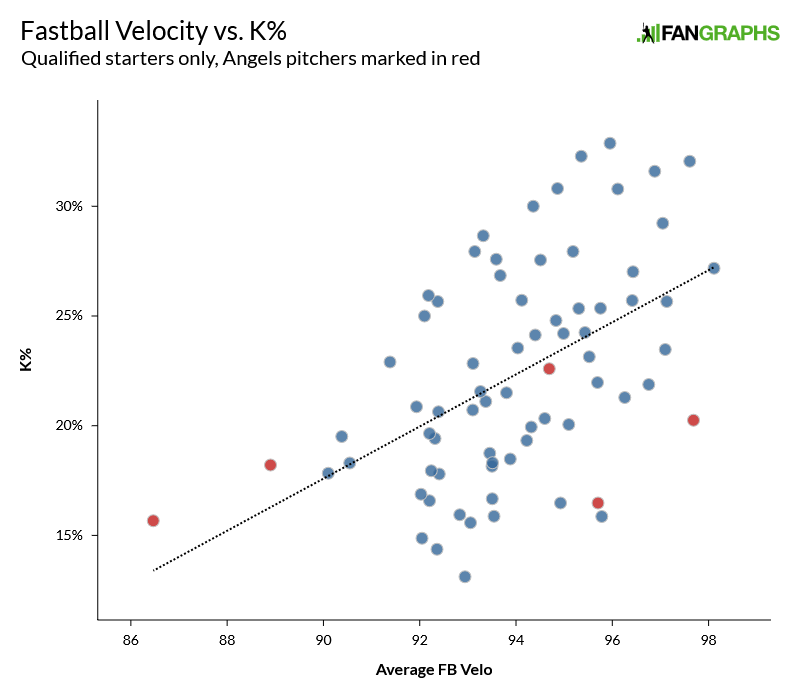Ball Moves Pretty Fast. You Probably Won’t Miss It.

Earlier this week, I was writing about Reds rookie Chase Burns, the hard-throwing former Tennessee and Wake Forest ace who was about to make his first major league start. Burns throws really hard — always has — so I dialed up the fastball velocity leaderboard to see how he stacked up against starters at the major league level. (Quite well, it turns out.)
Anyway, the Angels have a couple guys who are pretty high on that list. José Soriano’s four-seamer averages 97.7 mph, which is one-tenth of a mile short of what Burns managed in two Triple-A starts, but up here in the real-world majors, that makes him the hardest-throwing qualified starter apart from Paul Skenes. Tarik Skubal? Jacob deGrom? Dylan Cease? Those guys can go take a hike.
Soriano’s teammate, Jack Kochanowicz, is no. 16 on the starter velocity leaderboard. I’ll forever associate Kochanowicz with a game I caught near the end of last year when the White Sox were bumping up against their 120th loss. I went into it wondering why I’d chosen a profession that obligated me to watch a meaningless September game between two truly dreadful teams, but it ended up being a pretty good game, a pitchers duel between two enormous, hard-throwing rookie starters: the 6-foot-7 Kochanowicz and the 6-foot-6 White Sox righty Jonathan Cannon.
Yusei Kikuchi throws hard for a lefty; so does Reid Detmers, who isn’t in the rotation anymore, but he’s been slinging it at 95-plus out of the pen. The Angels don’t exclusively chase four-seamer velo when acquiring pitchers — this is, after all, a team that just signed Kenley Jansen and Kyle Hendricks this past offseason — but they do like a hard-thrower. Robert Stephenson managed to throw just two four-seamers this season before he was stricken with biceps inflammation, but those two pitches came in at 97.9 mph and 98.5 mph.
You can even see the Angels’ affinity for velocity in their recent prospect acquisitions. Ahead of last season’s deadline they traded for hard-throwing righty George Klassen. They drafted Chris Cortez last year, and Ben Joyce — Burns’ one-time teammate and the hardest-throwing college reliever of all time — back in 2022.
Which reminds me: Joyce might be able to throw 105, but his strikeout rate and whiff rate historically have been puzzlingly light for a guy with such a potent arm. The same is true of Soriano, and Kochanowicz, and to a certain extent Kikuchi.
Despite all that velo, the Angels, as a staff, are just 24th in strikeout rate and 15th in overall whiff rate, while leading the league in walk rate. Am I overrating the correlation between velocity and strikeouts? Perhaps. Some people (ironically, usually people who soil their unmentionables at the mere thought of Nolan Ryan) say velocity is overrated, and young pitchers’ obsession with speed is to their detriment.
Well, let’s find out. This season, nearly 300 pitchers have thrown at least 30 innings in the majors; I plotted the average velocity of their hardest fastballs (four-seamer, sinker, whatever it may be) against their strikeout rates.

No, turns out that as velocity goes up, strikeouts go up. The opposite is true for contact rate, which is what a pitcher wants; higher strikeout rate is good, higher contact rate is bad.

So far this season, the Angels have 10 pitchers who’ve thrown at least one inning and registered an above-average mean fastball velocity.
| Name | Velo | G | IP | ERA | FIP | K% | BB% | Contact% |
|---|---|---|---|---|---|---|---|---|
| Ben Joyce | 101.1 | 5 | 4 1/3 | 6.23 | 6.31 | 5.0% | 5.0% | 75.6% |
| Robert Stephenson | 98.2 | 2 | 1 | 0.00 | -0.93 | 66.7% | 0.0% | 25.0% |
| José Soriano | 97.7 | 16 | 93 | 3.39 | 3.23 | 20.3% | 10.9% | 74.4% |
| Ryan Zeferjahn | 97.4 | 33 | 28 1/3 | 4.76 | 4.98 | 29.0% | 11.3% | 71.7% |
| José Fermin | 97.1 | 10 | 9 1/3 | 4.82 | 4.57 | 33.3% | 11.1% | 68.8% |
| Jack Kochanowicz | 95.7 | 16 | 82 | 5.49 | 5.62 | 16.5% | 10.6% | 80.4% |
| Brock Burke | 95.6 | 36 | 30 2/3 | 4.11 | 4.74 | 18.6% | 10.7% | 79.4% |
| Connor Brogdon | 95.3 | 17 | 17 2/3 | 5.60 | 5.62 | 18.9% | 9.5% | 73.2% |
| Reid Detmers | 95.3 | 30 | 33 | 4.64 | 2.80 | 30.1% | 11.9% | 70.1% |
| Yusei Kikuchi | 94.7 | 16 | 89 2/3 | 3.01 | 4.20 | 22.6% | 11.2% | 78.5% |
| League Average | 94.3 | — | — | 4.06 | 4.06 | 21.9% | 8.5% | 77.1% |
Joyce and Stephenson got hurt before they could put up meaningful numbers, but every other hard-throwing Angels pitcher has a higher-than-average walk rate, accompanied in most cases by an unremarkable strikeout rate. Certainly none of these guys, with their 97-mph fastballs and double-digit walk rates, are putting up prime Edwin Díaz strikeout numbers or anything.
Least of all Kochanowicz. The big right-hander had a pretty good rookie season by anyone’s standards: 11 starts, 65 1/3 innings, a 3.99 ERA. But he struck out only 25 batters, which is a K/9 of 3.44 and a K% of 9.5%. That wasn’t just the lowest strikeout rate in the league last year, it’s the lowest strikeout rate in a season of 60 or more innings since 2017. I truly did not know it was possible to post a strikeout rate that low in the 2020s.
It’s gotten better in 2025, but not by much. Kochanowicz is striking out just 16.5% of opponents — a bottom-10 figure among qualified starters — with a walk rate of 10.6%. That gives him the fourth-lowest K-BB% in the league. And I’m not a FIP absolutist or anything, but Kochanowicz isn’t generating outlier-level soft contact; opponents are hitting .283 against him, with a .308 BABIP and a 4.96 xERA.
Let’s go back to that velocity-versus-K% graph, except this time let’s restrict the sample to qualified starters.

The two red dots off to the left are Hendricks and Tyler Anderson, and yes, I’m aware that while I’ve been writing about their organizational fixation on fastball velocity, the Halos have employed the two soft-tossing-est starters in the league.
Kikuchi is the red dot just about on the trend line, while Kochanowicz and Soriano are high-velo/low-strikeout outliers. Are they just throwing the same stuff?
| Four-Seamer | Pitch Type | Pitch % | Velo | Spin (RPM) | H-Mov | IVB | Whiff% |
|---|---|---|---|---|---|---|---|
| Jack Kochanowicz | FF | 18.2 | 95.7 | 2,254 | 7.5 ARM | 14.1 | 23.3 |
| José Soriano | FF | 7.4 | 97.7 | 2,192 | 8.3 ARM | 13.5 | 20.5 |
| Sinker | Pitch Type | Pitch % | Velo | Spin (RPM) | H-Mov | IVB | Whiff% |
| Jack Kochanowicz | SI | 48.3 | 95.6 | 2,137 | 14.5 ARM | 2.9 | 16.4 |
| José Soriano | SI | 50.8 | 97.1 | 1,910 | 13.0 ARM | 3.1 | 18.3 |
| Changeup | Pitch Type | Pitch % | Velo | Spin (RPM) | H-Mov | IVB | Whiff% |
| Jack Kochanowicz | CH | 12.1 | 89.7 | 2,107 | 8.1 ARM | 3.3 | 30.9 |
| José Soriano | FS | 7.6 | 91.8 | 1,441 | 10.1 ARM | -0.4 | 36.0 |
| Slider | Pitch Type | Pitch % | Velo | Spin (RPM) | H-Mov | IVB | Whiff% |
| Jack Kochanowicz | SL | 15.4 | 87.4 | 2,727 | 3.1 GLV | 0.0 | 28.4 |
| José Soriano | SL | 7.7 | 89.0 | 2,396 | 1.9 GLV | -0.5 | 46.9 |
| Other Breaking Ball | Pitch Type | Pitch % | Velo | Spin (RPM) | H-Mov | IVB | Whiff% |
| Jack Kochanowicz | ST | 6.0 | 82.5 | 2,828 | 13.6 GLV | -2.3 | 32.3 |
| José Soriano | KC | 26.5 | 85.2 | 2,502 | 12.0 GLV | -9.9 | 41.3 |
The secondary pitches are different, but both pitchers throw more sinkers than four-seamers, and with similar movement profiles. And these fastballs are just not getting swings and misses. Soriano can get whiffs with all three of his secondaries, but not Kochanowicz.
I ended by trying to figure out if there was something about these two fastball movement profiles that generated certain results. So I went into Baseball Savant and searched for all four-seamers that averaged between 94 and 98 mph, with between 13 and 15 inches of induced vertical break and between seven and nine inches of horizontal break. Only four pitchers have thrown such a pitch 100 or more times this year, including Kochanowicz and Soriano.
I moved on to sinkers, 94 mph or harder, with between zero and four inches of IVB and between 12 and 16 inches of arm-side movement. Three pitchers: Soriano, Kochanowicz, and Noah Murdock of the Port Ruppert Athletics. Murdock doesn’t throw a four-seamer at all.
You can teach velo nowadays. At the draft combine, I talked to a pitcher who was throwing mid-80s early in high school, topped out at 101 as a college junior, and aims to hit 102 or 103 in the future. It’s possible.
But it’s hard. Guys who can throw as hard as Soriano and Kochanowicz with any kind of control on a starter’s workload are quite rare. They just haven’t figured out how to miss bats. Given the same thing happened to Joyce, it’s worth monitoring Cortez and Klassen as they move up the ladder, because it’s possible this problem is systemic.
Michael is a writer at FanGraphs. Previously, he was a staff writer at The Ringer and D1Baseball, and his work has appeared at Grantland, Baseball Prospectus, The Atlantic, ESPN.com, and various ill-remembered Phillies blogs. Follow him on Twitter, if you must, @MichaelBaumann.
The Angels are a fascinating team for a lot of reasons but this article touches on one of them.
Jack K could maybe induce a few more whiffs by using his change more but his breaking stuff just isn’t good enough. Maybe he can rework his slider into a sweeper this offseason. When Soriano is throwing strikes he’s nasty. But both guys are “fun” to watch with their high velo bowling ball sinkers.
I miss Chien Ming Wang
Maybe I’m remembering wrong, but wasn’t Kochanowicz considered to have a really good curve in earlier scouting reports?
FG had him as a 50/55 on the SL and 45/45 on the CB on their 2024 LAA prospects list. BA put a 50 on the SL and 45 on the CB.
In your defense BA had a 60 projection on his CB back in 2021 and in both 2021 and 2022 called it “a potential plus pitch.”